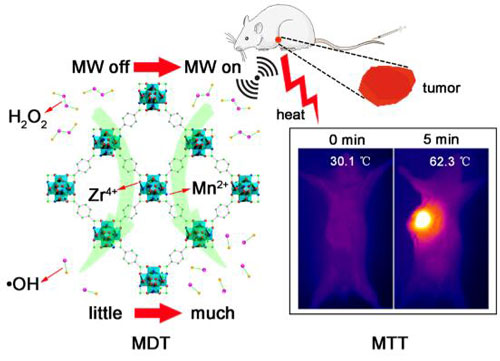| Posted: Jan 08, 2018 | |
New insights into highly effective combination of microwave dynamic and thermal therapies against cancer |
|
| (Nanowerk Spotlight) Researchers in China at the Technical Institute of Physics and Chemistry, Chinese Academy of Sciences propose novel flexible Mn-doped zirconium metal-organic frameworks (Mn-ZrMOF) nanocubes (NCs) for highly effective combination of microwave dynamic and thermal therapy against cancer. The search for efficient anti-tumor therapies is highly desirable because of the unsatisfactory therapeutic efficiency of the traditional therapies like surgery, chemotherapy, and radiotherapy. | |
| Recently, microwave thermal therapy (MTT) has been widely regarded as a promising therapy due to the simple operation, high efficiency, and small side effects. However, the recurrence rate of the traditional MTT is too high because of the limited ablation area for tumor. Thus, we still need to find a better and safer synergistic therapy to improve the therapeutic effect of MTT. | |
| Dynamic therapy based on reactive oxygen species (ROS) can destroy the cancer cells and suppress the growth of tumors. Typically, photodynamic therapy (PDT) has been applied as a site-specific targeting treatment for suppressing the growth of tumors in clinical applications. | |
| A combination of MTT and microwave dynamic therapy (MDT) with simultaneous production of thermal effects and ROS by microwave activation seems to be a more appealing synergistic therapy to enhance antitumor efficacy, but still challenging. To the best of our knowledge, there is still no report of such a synergistic therapy for treating tumors to date. | |
| Recently, metal-organic frameworks (MOFs) formed by metal ions and organic bridging ligands have been found to have great potential for biological applications due to their beneficial features of tunable size, shape, soft porous crystals, and intrinsic biodegradability. Although huge progress has been made on PTT or PDT by MOFs, other properties and applications of MOFs should be further explored. | |
| The research team proposes the first case of using Mn2+-doped Zr metal-organic framework nanocubes (Mn-ZrMOF NCs) for realizing the synergic treatment of tumors by combining MTT and MDT. | |
 |
|
| A new-style flexible Mn-doped zirconium metal-organic frameworks (Mn-ZrMOF) nanocubes (NCs) were prepared easily by one-pot hydrothermal method for highly effective combination of microwave dynamic and thermal therapy against cancer. (Reprinted with permission by American Chemical Society) | |
| The results are described in the journal ACS Nano ("Microwave-Activated Mn-Doped Zirconium Metal-Organic Frameworks Nanocubes for Highly Effective Combination of Microwave Dynamic and Thermal Therapy Against Cancer"). | |
| Due to the strong inelastic collision of ions confined in a large number of micropores, the Mn- ZrMOF NCs were demonstrated to be an effective microwave-sensitive agent with a high thermal conversion efficiency up to 28.7%, which is the highest one of the recently reported microwave-sensitive agents. | |
| This is the first report of determining the microwave thermal conversion efficiency, which can be used to evaluate, compare, and predict the microwave sensitivity of different microwave-sensitive agents. More importantly, such Mn-ZrMOF NCs generate abundant reactive oxygen species (ROS) of hydroxyl radicals under microwave irradiation. | |
| As such, the Mn-ZrMOF NCs efficiently suppress the tumor cell growth in vivo and in vitro under mild microwave irradiation for the synergic effect of MTT and MDT. | |
| Dr. Xianwei Meng who led the research team said: "This work paves the way for developing nanoagents that are responsive to microwave irradiation, producing ROS and improving thermal effects to realize the noninvasive MTT and MDT treatment in clinics." | |
|
Source: Technical Institute of Physics and Chemistry, Chinese Academy of Sciences
|
|
|
Become a Spotlight guest author! Join our large and growing group of guest contributors. Have you just published a scientific paper or have other exciting developments to share with the nanotechnology community? Here is how to publish on nanowerk.com. |
|
